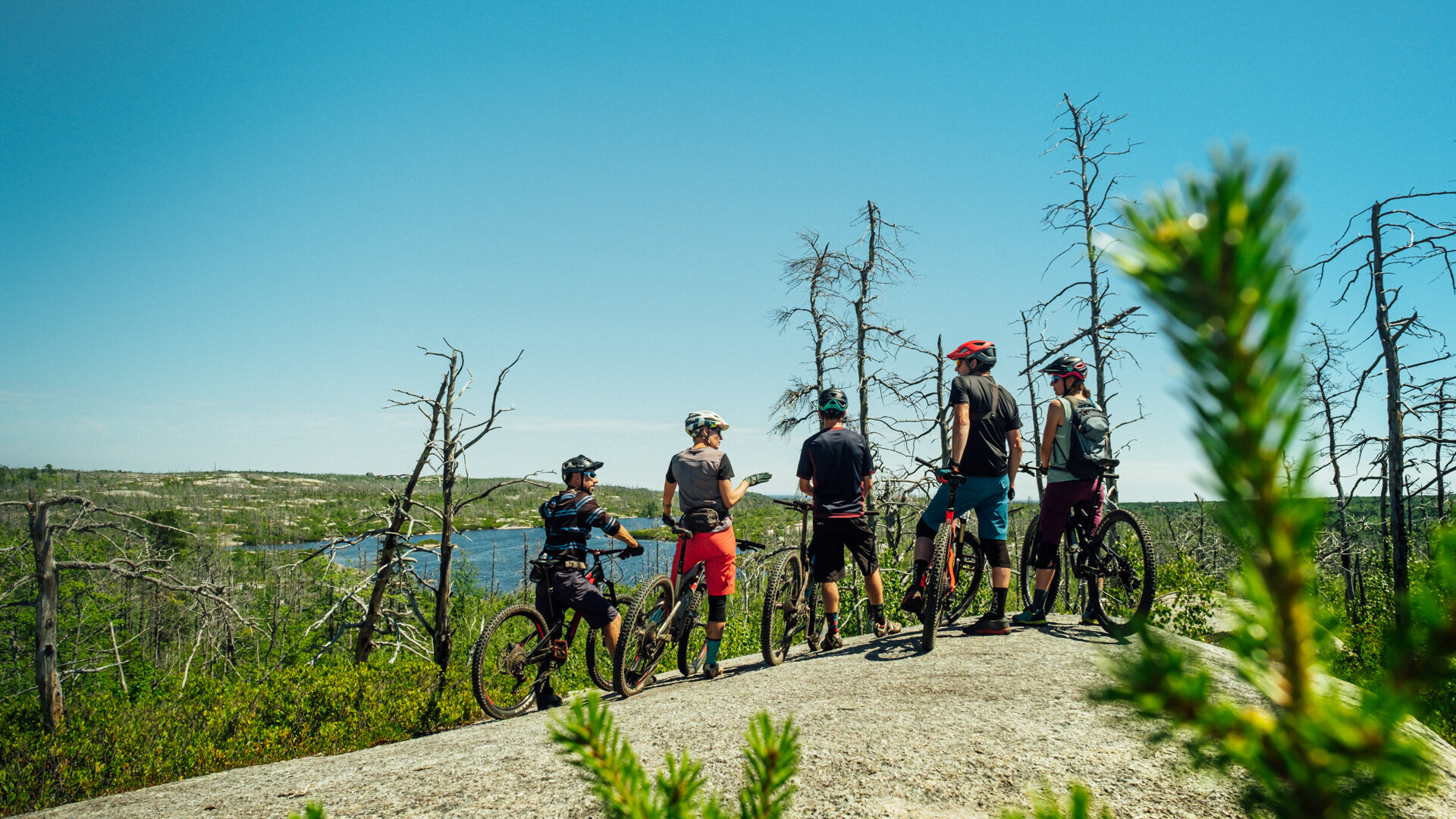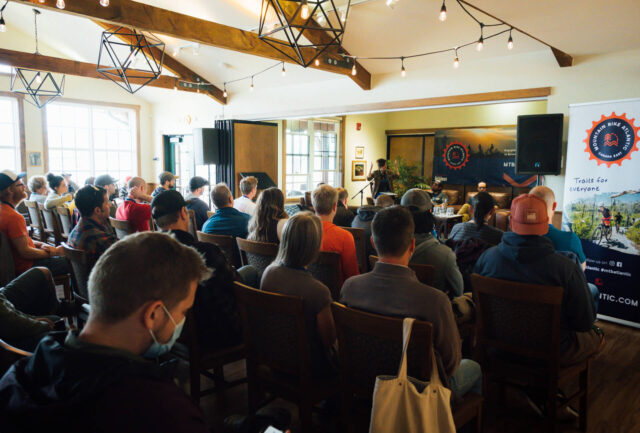Singletrack’s Impact on Community Quality of Life and Economic Development

Contributed by Justine Jenkins, Lauren Green and Jackie Oncescu, PhD and Mountain Bike Atlantic Advisory Committee Member
June 2020
Riders are travelling more frequently and further distances to take their mountain bikes for a ‘rip’, resulting in not only mountain bikers ‘sending it’ on the track, but also into the local trail community economy.
The popularity of mountain biking has grown substantially over the last 30 years and can be classified as one of the fastest-growing outdoor recreation activities worldwide [1]. Research has found this growth in biking to be an opportunity for local communities, whether bikers are doing day rides, group rides, or a sanctioned race or everything in between. They all have a direct and indirect impact on the community and its economic development [2] [3]. As the outdoor activity is known to cultivate social benefits for residents, it also plays a role in diversifying local economies.
one of the fastest-growing outdoor recreation activities worldwide
Community development and economic development can have multiple benefits for communities. A way to link the two would be to think of community development as supplying the assets to improve quality of life, while economic development can help assemble these assets to the benefit of the community with improved investments and quality of life outcomes [4]. In terms of tourism, mountain biking can boost local community economies and can spark interest in future economic and social development opportunities. Proving social and environmental benefits develop through economic investment in mountain biking, and the justification for local governments can be used to further develop the sector and develop communities [2]. In most cases, local mountain biking infrastructure starts with community development. We believe community development is the most important element to the success of mountain biking, whether it’s for local use or a potential tourism product, as it requires local resident (or club) knowledge, skills and commitment to develop the infrastructure to participate. Without local clubs and volunteers many trails would not exist. A common thread amoung attractive mountain biking trail systems are communities that have strong trail networks, a vibrant local community with trail building and advocacy skills, and a solid local bike culture. In part, investing in local trail groups/clubs will not only enhance quality of life for residents (riders and non-riders), but can have an economic impact on the broader community.
We believe community development is the most important element to the success of mountain biking…Without local clubs and volunteers many trails would not exist
‘An economic kicker for the community’
The business behind mountain biking has led to the activity being a provider of opportunities that benefit both communities and riders [5], including advancing communities’ tourism products. Tourism strategies that have been formed around cycling are often utilized to diversify and/or revitalization communities’ economies [6]. The popularity of mountain biking in relation to adventure tourism, is related to the diversity in riding styles and terrain, which has made various different locations and experiences possible attractions [5].
Considerable success has been seen with the investment and development of trail systems, attracting visitors through the hosting of events or through general visitation for rides on trail networks [6]. Communities featuring mountain biking have benefited and have seen economic, social, cultural, and environmental benefits from the activity [5]. Some of these benefits for stakeholders and include:
- Increased exposure and opportunities for recreational mountain biking participation amoung local populations;
- Increased awareness of mountain biking destinations and tourist visitation;
- Tourism and taxation revenues increase;
- Improvements and development are seen in terms of community infrastructure;
- Indirect spin-off effects for other community organizations and businesses;
- Support of recreation and community social development; and
- Networking and social capital development [5].
In addition to endorsing the growth of tourism around Atlantic Canada, the development of mountain biking infrastructure, services, and supporting amenities may deliver a range of significant benefits for many communities [5]. Along with investments, comes the direct and indirect impacts of riders spending on bike trips (e.g., expenditure on food, lodging, and transportation traveling to and from a mountain biking site) and equipment (e.g., the bikes themselves, helmets, clothing) has been seen as a substantial amount throughout many communities [7]. This recreational spending can result in increased household and store owner income; for instance, as bikers are travelling into different communities, they purchase food and gas at service stations located near the mountain biking sites [7]. As well, riders will often purchase cycling equipment at local retail sport stores, which can lead to an increased income for local businesses. It is suggested that the extra spending done by mountain bikers contributes to the local economy [7].
Community Revitalization: ‘Upshifting community quality of life’
Mountain biking is also a mechanism to revitalize community life, particularly for rural and remote communities. With economic downturns in natural resource extraction (e.g. mill closures, mine closures, fishing industry collapse, etc.), rural communities are hit the hardest. Revitalization can be made possible when communities develop alternative economic spaces through local cultural and natural assets. With diverse living conditions and distinctive natural environments, rural and remote communities typically foster a unique way of life, often displayed through recreational activities [10]. Mountain biking can be a gateway for riders to connect to rural and remote regions where unique historical and cultural landscapes of Canadian society exist. When communities build a sense of identity around their local culture and natural amenities, it can cultivate community pride among residents that contributes to their quality of life. Many people experience their sense of, and connection to, community through engagement in recreation. For many rural residents, the outdoor landscape and the recreation activities that take place with it, are experiences that enhance their quality of life. Meaning, mountain biking is not just about tourism and economic development, but residents’ community pride, cohesion, and overall well being.
Mountain biking can be a gateway for riders to connect to rural and remote regions
There are several examples of mountain biking playing a significant role in rural community revitalization. Highlighting the community of Minto, New Brunswick, shows the renewal and boost that mountain biking has brought to the community after the coal mine closure [8]. Cumberland, BC, a former coal mining village (pop. 3700), has gone from ghost town to a mountain biking mecca. The village of Carcross, Yukon, population 301, revitalized their community through mountain biking and has become a sought-after destination in the far North. Internationally, Derby, Australia, a former tin mining town has built over 125km of trails that have transformed the community’s identity and attracted new residents that are in pursuit of living an active leisure lifestyle. In some of these cases, the revitalization started with mountain biking, but over time these communities were able to invest in other outdoor pursuits and cultural experiences that have enhanced the quality of life for residents and the visitors’ experiences.
mountain biking was a catalyst
Interestingly, these communities share similar economic histories and trajectories, and mountain biking was a catalyst to preserve and share the rich cultural and historical stories embedded in these regions. As these communities change, so does access to recreation or the way the recreation is experienced [10]. Research shows that recreation is being experienced differently than in the past in rural communities, which could be connected to the growing rates of mountain biking.
As we conclude, we want to highlight that despite the social and economical benefits to community life, developments in relation to mountain biking, tourism or otherwise, can be fraught with tension and resistance—but that topic is a blog post for another day.
there is a positive economic spin off for communities, meaning investing in mountain biking is an investment in community.
It is clear that Atlantic Canada has a strong sense of community development in relation to mountain biking, as there are several awesome trail networks across the region. This speaks volumes to the riders, bike clubs, and trail groups that are committed to developing mountain biking, and consequently their residents’ quality of life. It also highlights the economic investment that has come from residents, private businesses, local and provincial governments. As riders are attracted to a healthy local scene, a solid trail system and culture [11], there is a positive economic spin-off for communities, meaning investing in mountain biking is an investment in the community.
However, for us, we think mountain biking is so much more than a rip on a trail and a boost to the local economy, it is also an investment in preserving Atlantic Canada’s natural environment, culture, history, and rural and remote communities. Making mountain biking a pretty awesome way to explore and experience what Atlantic Canada has to offer.
Sources:
[1] Rowsell, B. (2013). Mountain bike tourism development under the midnight sun: Capitalizing on destination attributes to maximize tourism potential in the Yukon Territory. Canada (MA NRES thesis), University of Northern British Columbia, Prince George, Canada.
[2] Meltzer, N. (2014). Adapting to the new economy: The impacts of mountain bike tourism in Oakridge, Oregon.
[3] Boozer, B. B., Self, M., & Jankoski, M. J. (2012). An economic and impact analysis of the Coldwater mountain bike trail. Report for the Calhoun County Community Development Corporation. Available at: https://headwaterseconomics. org/wp content/uploads/Trail_Study_13-coldwater-mountain-bike-trail. pdf (accessed 15 August 2018).
[4] Sharpe, E., Mair, H., & Yuen, F. (Eds.). (2016). Community development: Applications for leisure, sport, and tourism. State College, PA: Venture Publishing.
[5] Freeman, R. (2011). Mountain Bike Tourism and Community Development In British Columbia: Critical Success Factors for the Future.
[6] Buning, R. J., & Lamont, M. (2020). Mountain bike tourism economic impacts: A critical analysis of academic and practitioner studies. Tourism Economics, 135481662090195.
[7] Southwick, R., Bergstrom, J., & Wall, C. (2009). The economic contributions of human-powered outdoor recreation to the US economy. Tourism Economics, 15(4), 709-733.
[8] McKall, T. (2018, June 23). Coal Miner’s Lung celebrates Minto’s move from mines to mountain bikes. Retrieved from https://cyclingmagazine.ca/mtb/coal-miners-lung-celebrates-mintos-move-from-mines-to-mountain-bikes/
[9] Gould, A. (2018). From ‘mud dumps’ to top-notch trails: How the Minto coal … (June 4, 2018). Retrieved May 22, 2020, from https://www.cbc.ca/news/canada/new-brunswick/mud-dumps-to-trails-1.4687541
[10] Oncescu, J., & Robertson, B. (2010). Recreation in remote communities: A case study of a Nova Scotian Village. Journal of Rural Community Development, 5 1/2., 221-237.
[11[ Lau, L. (2014). Economic impacts of mountain biking tourism. Retrieved June 3rd 2020, from https://www.pinkbike.com/u/leelau/blog/economic-impacts-of-mountain-biking-tourism.html?utm_source=facebook.com&utm_medium=referral&utm_campaign=fb-like#commentform



